I've a dataset similar to the one below.
I need to update the base lookup table based on the values provided in the updated_CustomerId column. The base tables is the same as the dataset but it does not have updated_CustomerId column.
The challenge here that the base table has a unique constraint based on combination of three columns below:
Current_CustomerID
Order_ID
OrderCategory
DESIRED OUTPUT:
After the update either one of Old_customerIds (17360410 - Pk 8, 21044488 - Pk = 9) can be reassigned to the Update_CustomerID PrimaryKey 2 will not updated as that would lead to Unique constraint violation, but it will then be deleted along with one of the PrimaryKeys from the above either 8 or 9, depending on which one was updated (re-assigned to the new id)
After everything is updated on the base table I then delete from the base table all records where Current_CustomerID was not re-assigned to the updated_CustomerId (if different)
IF OBJECT_ID('tempdb..#DataSet') IS NOT NULL
DROP TABLE #DataSet
IF OBJECT_ID('tempdb..#BaseTable') IS NOT NULL
DROP TABLE #BaseTable
CREATE TABLE #DataSet
(
PrimaryKey INT NOT NULL CONSTRAINT [PK_dataset_ID] PRIMARY KEY,
Current_CustomerID INT NOT NULL,
Order_ID INT NOT NULL,
OrderCategory VARCHAR(50) NOT NULL,
Updated_CustomerId INT NOT NULL
)
INSERT INTO #DataSet (PrimaryKey, Current_CustomerID, Order_ID, OrderCategory, updated_CustomerId)
VALUES
(1, 17395001, 4451784, 'Kitchen', 25693110),
(2, 25693110, 4451784, 'Kitchen', 25693110),
(3, 25693110, 2083059, 'Kitchen', 25693110),
(4, 25693110, 2163679, 'Kitchen', 25693110),
(5, 25693110, 2171466, 'Kitchen', 25693110),
(6, 25693110, 2163679, 'Bathroom', 25693110),
(7, 25693110, 2171466, 'Bathroom', 25693110),
(8, 17360410, 3377931, 'Furniture', 16303984),
(9, 21044488, 3377931, 'Furniture', 16303984),
(10, 1534323, 2641714, 'Furniture', 16303984),
(11, 16303984, 2641726, 'Furniture', 16303984),
(12, 16303984, 2641793, 'Furniture', 16303984),
(13, 16303984, 2641816, 'Furniture', 16303984),
(14, 16303345, 2641816, 'Garden', 16301239),
(15, 12345678, 1239065, 'Medicine', 1075432)
CREATE TABLE #BaseTable
(
PrimaryKey INT NOT NULL CONSTRAINT [PK_baseTable_ID] PRIMARY KEY,
CustomerID INT NOT NULL,
Order_ID INT NOT NULL,
OrderCategory VARCHAR(50) NOT NULL,
)
CREATE UNIQUE NONCLUSTERED INDEX [IDX_LookUp] ON #BaseTable
(
CustomerID ASC,
Order_ID ASC,
OrderCategory ASC
) ON [PRIMARY]
INSERT INTO #BaseTable (PrimaryKey, CustomerID, Order_ID, OrderCategory)
VALUES
(1, 17395001, 4451784, 'Kitchen'),
(2, 25693110, 4451784, 'Kitchen'),
(3, 25693110, 2083059, 'Kitchen'),
(4, 25693110, 2163679, 'Kitchen'),
(5, 25693110, 2171466, 'Kitchen'),
(6, 25693110, 2163679, 'Bathroom'),
(7, 25693110, 2171466, 'Bathroom'),
(8, 17360410, 3377931, 'Furniture'),
(9, 21044488, 3377931, 'Furniture'),
(10, 1534323, 2641714, 'Furniture'),
(11, 16303984, 2641726, 'Furniture'),
(12, 16303984, 2641793, 'Furniture'),
(13, 16303984, 2641816, 'Furniture'),
(14, 16303345, 2641816, 'Garden'),
(15, 12345678, 1239065, 'Medicine')
-- select * from #BaseTable
-- select * from #DataSet
; with CTE AS (
select a.*
,rank() over (partition by a.updated_CustomerId, a.Order_ID, a.OrderCategory
order by a.Current_CustomerID) as flag
from #DataSet a
)
with CTE AS (
select a.*
,rank() over (partition by a.updated_CustomerId, a.Order_ID, a.OrderCategory order by a.Current_CustomerID) as flag
from #DataSet a
)
update b
set CustomerID = a.Updated_CustomerId
from #BaseTable b
inner join CTE a on b.PrimaryKey = a.PrimaryKey
where flag <> 2
Msg 2601, Level 14, State 1, Line 82 Cannot insert duplicate key row in object 'dbo.#BaseTable' with unique index 'IDX_LookUp'. The duplicate key value is (25693110, 4451784, Kitchen). The statement has been terminated.

